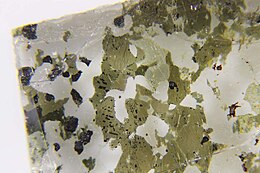
Greenockite is a rare cadmium bearing metal sulfide mineral consisting of cadmium sulfide (CdS) in crystalline form. Greenockite crystallizes in the hexagonal system. It occurs as massive encrustations and as hemimorphic six-sided pyramidal crystals which vary in color from a honey yellow through shades of red to brown. The Mohs hardness is 3 to 3.5 and the specific gravity is 4.8 to 4.9.

Hemimorphite is the chemical compound Zn4(Si2O7)(OH)2·H2O, a component of mineral calamine. It is a silicate mineral which, together with smithsonite (ZnCO3), has been historically mined from the upper parts of zinc and lead ores. Both compounds were originally believed to be the same mineral and classified as calamine. In the second half of the 18th century, it was discovered that these two different compounds were both present in calamine. They closely resemble one another.

Germanite is a rare copper iron germanium sulfide mineral, Cu26Fe4Ge4S32. It was first discovered in 1922, and named for its germanium content. It is only a minor source of this important semiconductor element, which is mainly derived from the processing of the zinc sulfide mineral sphalerite. Germanite contains gallium, zinc, molybdenum, arsenic, and vanadium as impurities.

Zincite is the mineral form of zinc oxide (ZnO). Its crystal form is rare in nature; a notable exception to this is at the Franklin and Sterling Hill Mines in New Jersey, an area also famed for its many fluorescent minerals. It has a hexagonal crystal structure and a color that depends on the presence of impurities. The zincite found at the Franklin Furnace is red-colored, mostly due to iron and manganese dopants, and associated with willemite and franklinite.
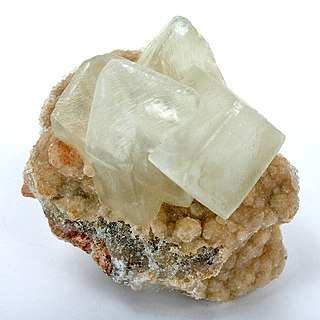
Smithsonite, also known as zinc spar, is the mineral form of zinc carbonate (ZnCO3). Historically, smithsonite was identified with hemimorphite before it was realized that they were two different minerals. The two minerals are very similar in appearance and the term calamine has been used for both, leading to some confusion. The distinct mineral smithsonite was named in 1832 by François Sulpice Beudant in honor of English chemist and mineralogist James Smithson (c.1765–1829), who first identified the mineral in 1802.

Hydrozincite, also known as zinc bloom or marionite, is a white carbonate mineral consisting of Zn5(CO3)2(OH)6. It is usually found in massive rather than crystalline form.

Aurichalcite is a carbonate mineral, usually found as a secondary mineral in copper and zinc deposits. Its chemical formula is (Zn,Cu)5(CO3)2(OH)6. The zinc to copper ratio is about 5:4.

Wurtzite is a zinc and iron sulfide mineral with the chemical formula (Zn,Fe)S, a less frequently encountered structural polymorph form of sphalerite. The iron content is variable up to eight percent. It is trimorphous with matraite and sphalerite.
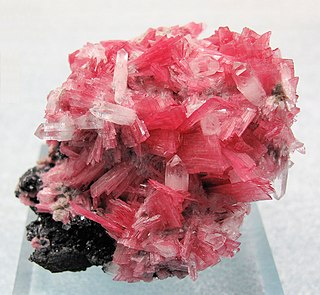
Rhodonite is a manganese inosilicate, (Mn, Fe, Mg, Ca)SiO3 and member of the pyroxenoid group of minerals, crystallizing in the triclinic system. It commonly occurs as cleavable to compact masses with a rose-red color (the name comes from the Greek ῥόδος rhodos, rosy), often tending to brown because of surface oxidation.

Adamite is a zinc arsenate hydroxide mineral, Zn2AsO4OH. It is a mineral that typically occurs in the oxidized or weathered zone above zinc ore occurrences. Pure adamite is colorless, but usually it possess yellow color due to Fe compounds admixture. Tints of green also occur and are connected with copper substitutions in the mineral structure. Olivenite is a copper arsenate that is isostructural with adamite and there is considerable substitution between zinc and copper resulting in an intermediate called cuproadamite. Zincolivenite is a recently discovered mineral being an intermediate mineral with formula CuZn(AsO4)(OH). Manganese, cobalt, and nickel also substitute in the structure. An analogous zinc phosphate, tarbuttite, is known.

Nsutite is a manganese oxide mineral with formula: (Mn4+1−xMn2+xO2-2x(OH)2x where x = 0.06-0.07). It is found in most large manganese deposits and was first discovered in Nsuta, Ghana. Since then, it has been found worldwide. Nsutite is a dull mineral with a hardness of 6.5-8.5 and an average specific gravity of 4.45. Nustite is used as a cathode in zinc–carbon batteries, but synthetic manganese oxide is gradually replacing it.

Fraipontite is a zinc aluminium silicate mineral with a formula of (Zn,Al)3(Si,Al)2O5(OH)4.
Zincobotryogen is a hydrous sulfate mineral with the chemical formula (Zn,Mg,Mn)Fe3+(SO4)2(OH)·7H2O. It forms bright orange red monoclinic prismatic crystals that exhibit a vitreous to greasy luster. Its specific gravity is 2.201 and it has a Mohs hardness of 2.5.
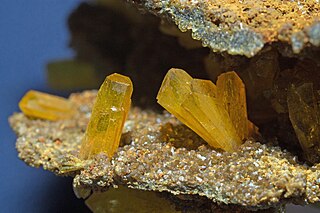
Legrandite is a rare zinc arsenate mineral, Zn2(AsO4)(OH)·(H2O).

Rosasite is a carbonate mineral with minor potential for use as a zinc and copper ore. Chemically, it is a copper zinc carbonate hydroxide with a copper to zinc ratio of 3:2, occurring in the secondary oxidation zone of copper-zinc deposits. It was originally discovered in 1908 in the Rosas mine in Sardinia, Italy, and is named after the location. Fibrous blue-green rosasite crystals are usually found in globular aggregates, often associated with red limonite and other colorful minerals. It is very similar to aurichalcite, but can be distinguished by its superior hardness.

Clinohedrite is a rare silicate mineral. Its chemical composition is a hydrous calcium-zinc silicate; CaZn(SiO4)·H2O. It crystallizes in the monoclinic system and typically occurs as veinlets and fracture coatings. It is commonly colorless, white to pale amethyst in color. It has perfect cleavage and the crystalline habit has a brilliant luster. It has a Mohs hardness of 5.5 and a specific gravity of 3.28 - 3.33.

Allactite is a rare arsenate mineral of metamorphosed manganese zinc ore deposits. It is found in Sweden and New Jersey, US. Its name originated from Greek αλλάκτειν (allaktein) meaning "to change", referring to the strong pleochroism of the mineral.
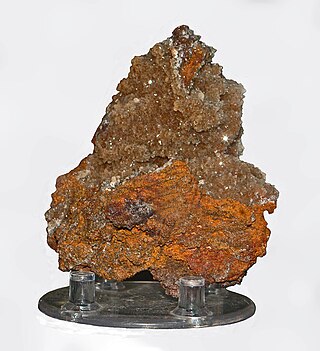
Tarbuttite is a rare phosphate mineral with formula Zn2(PO4)(OH). It was discovered in 1907 in what is now Zambia and named for Percy Coventry Tarbutt.
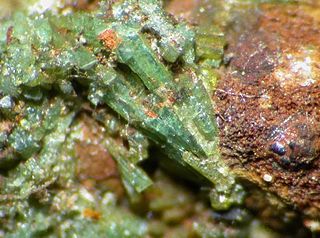
Zincolivenite is a copper zinc arsenate mineral with formula CuZn(AsO4)(OH) that is a member of the olivenite group. Its colors range from green to blue, and its name comes from its composition of zinc and olivenite.

Changoite is a rare zinc sulfate mineral with the formula Na2Zn(SO4)2·4H2O. Chagoite was discovered in the San Francisco Mine near Sierra Gorda, Antofagasta, Chile. The mineral is a zinc-analogue of blödite, cobaltoblödite, manganoblödite and nickelblödite - other representatives of the blödite group. In terms of chemistry changoite is somewhat similar to gordaite. The mineral's name comes from the early inhabitants of Chile - Changos.
